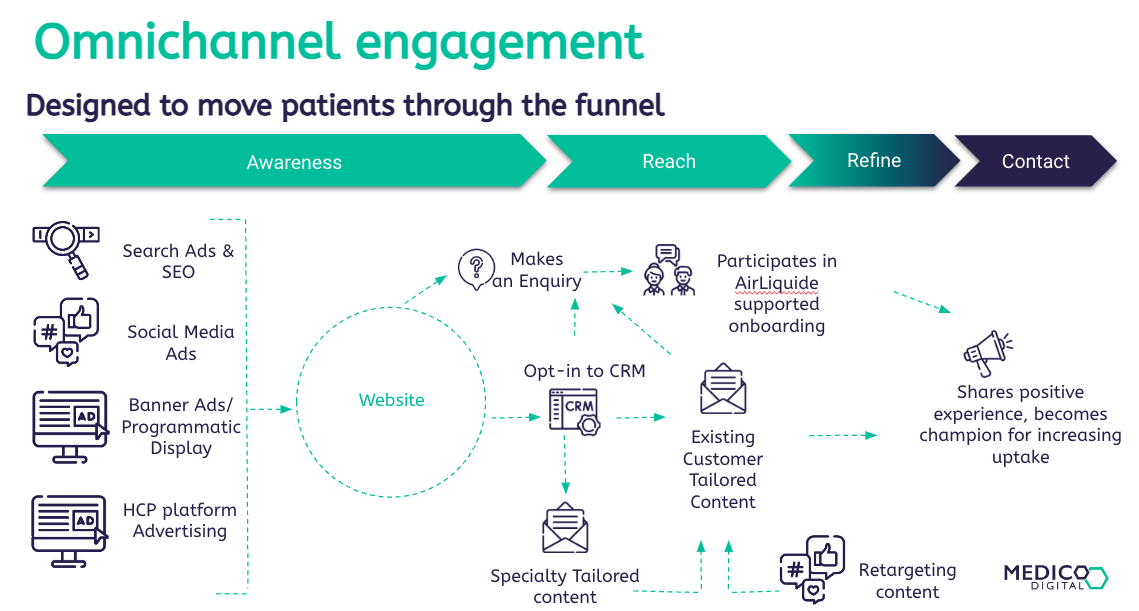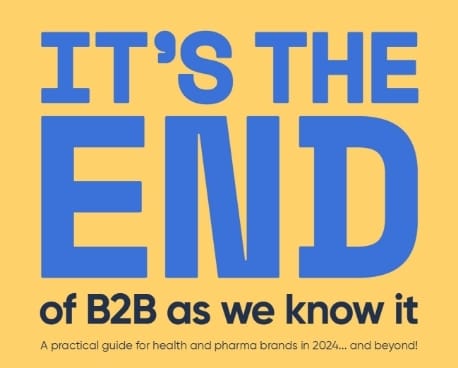The consequences of the regulatory restrictions imposed on pharmaceutical and healthcare companies can be seen in every area of the industry. In marketing and communications these consequences manifest in the slow pace of adoption of new technologies and strategies.
During the pandemic, this became a problem. Tried and tested, offline, traditional methods of communication were no longer reliable, and the industry had to quickly embrace digital, modern marketing methodologies.
The problem is, in the scramble to be more digital, some brands moved too fast, too quickly
In the space of 4 years the industry has gone from dusty, unchanged marketing strategies that have worked since the 90s to any online campaign that’s not part of a wider omnichannel strategy being deemed unfit for purpose.
There is now an industry wide attempt to keep up with the Joneses, a race to have touchpoints on the most marketing channels (aiming for quantity and sacrificing quality), and there is pure chaos when it comes to data attribution and understanding what is working for which audience.
Omnichannel has become a buzzword: a strategy that we all want to emulate, but few truly understand and fewer still have the resources to execute correctly.
We come bearing good news. You don’t have to achieve perfection in your marketing efforts, a little personalisation can go a long way. Read on to find out how you can more effectively communicate to your audience without needing to double the size of your marketing budget.

What is omnichannel
In a perfect world, omnichannel would be described as a seamless integration of messaging across both online and offline touch points as a patient or HCP moves down their sales funnel towards conversion.
The reality of executing a genuinely omnichannel campaign is that it’s incredibly challenging, resource intensive and costly.
At a minimum you would need a data management platform that is plumbed into each of your advertising channels, a way of integrating your offline activity, a detailed understanding of each sub-section of your target audience, an agile way of providing them with personalised communications and the ability to measure the success of your efforts.
Omnichannel VS. multichannel
A multichannel approach uses multiple different channels too, but the main difference is that they aren’t connected. For example, emails can be on one platform while company-wide updates can be delivered through a system like Microsoft Teams — neither of which is integrated with the other. Multichannel approaches leave a wider margin for error and a greater probability that necessary communications are missed.
While both strategies can be effective, omnichannel outperforms multichannel simply due to how user-friendly and connected it is. Omnichannel provides personalisation and convenience — something which HCPs need in their daily role.

The three pillars of omnichannel strategy
When it comes to adopting an omnichannel strategy, there are three pillars you need to consider: relevance, connectivity and measurability. Instead of leaving these pillars as an afterthought, we use them as foundations to build upon and shape strategic plans from the outset.
Relevance
The first pillar of an omnichannel strategy is relevance. This means ensuring your audience receives relevant communication. This can be achieved through data analysis and customer relationship management (CRM) tools as well as creating content that meets a specific educational need. The approach should not only be relevant but it should also positively affect behaviour and improve clinical practice. In an increasingly busy healthcare environment, relevant information that is easily accessible can make a huge difference to an HCP’s day.
Connectivity
Connectivity is vital for an omnichannel approach. It ensures that every piece of information your audience receives is part of a larger experience; delivering messages in a strategic, sequenced way to build a clear picture over time, rather than just delivering any message by any channel in any order. An omnichannel approach should promote connectivity and allow relationships between you and the consumer to strengthen, helping propel them through your adoption funnel. Connectivity increases user engagement and fully integrates the content into their experience.
Measurability
The final pillar is being able to measure the impact your communication strategies have. Data analytics are your best friend as they can help you monitor key metrics like engagement and response. This data is invaluable when it comes to perfecting your approach. By using the data you collect to create an actionable plan to enhance the omnichannel experience, you create a trusted, strong message for HCPs.
Who’s actually doing “omnichannel marketing”?
A great way to learn about the omnichannel experience is to look at those who do it well, like Spotify and Netflix. A lot can be learned from these companies that use an omnichannel approach while maintaining consistency in their user experience. Netflix does not create personalised content for each viewer. Instead, it uses smart data analytics and algorithms (similar to those used by Spotify) to guide you towards something you might like.
The way Netflix uses omnichannel solutions and integrates personalisation can be transferred to the healthcare industry to help you understand your specific audience and discover what their needs really are.

The good news is that you do not have to achieve pure omnichannel status to have a successful marketing campaign, and personalisation is easier to achieve than you might think. For example a tailored experience could be created for your niche HCP target audience simply by bucketing them into segments based on the types of media they engage with. You can then commit to producing more of the best performing media, and building out more segment specific touchpoints for that HCP audience, allowing them to take in your content in their own unique way, again and again until they take your desired action.
Spotify is a great example of this. They thrive off of personalisation. This is easily seen in their specially curated playlists that update each day based on your listening preferences. However, this doesn’t require extra effort on their part. In fact, it simply uses your data as a listener and gets to know you. Their AI will generate playlists and recommend other artists to you based on your previous data.
The same principle applies to omnichannel strategies in pharma and healthcare. By using data analytics, you can provide very specific messages to your audience in a way that is convenient for them.
.
Less is more
Our advice is always to start by focusing on a few things and doing them well.
Do your research and truly gain an understanding of your audience and where they go for information.
Create a channel neutral strategy that reflects the behaviour of your audience, don’t choose channels because your agency has a good relationship with the media company, or because you have seen other brands using them.
Segment your audience, and reframe your communications to appeal directly to those subsections.
Take your reframed communications and adapt them for each of the channels that you have thoughtfully chosen.
Set impactful KPIs. It might be that your overall objective is to increase your click through rate, reduce your CPMs or raise your impression share. But we doubt it.
Channel specific marketing metrics are very useful tools to monitor that your marketing is on track and that your efforts are cost effective, but don’t mistake jargon filled data reports as a substitute for your true objective.
You ultimately want conversions. You want booked patients. You want meaningful sales discussions with clinical stakeholders. Build your KPI set to support your true objective, not instead of it.
From there make sure you have a good understanding of the impact that your marketing efforts are having. This means joining up data and allowing yourself a holistic view of your customer’s journey through their different touchpoints with your brand. Paid search might have an astronomically high CPA (cost per acquisition) for you, but are you sure that it doesn’t play a pivotal step in warming up your audience to take action on their Veeva approved emails?
How to innovate
So you have end to end attribution sussed, you have a true understanding of your holistic CPA and you understand the relative value that each marketing channel is bringing you. Now you can begin to explore.
New channels, new messaging, new user journeys. Because you’re in a position to accurately interpret the data and decide what is and isn’t working.
Once you find what’s working, the key is to scale.
Take an omnichannel approach with the support of Medico Digital.
Sources
- Accenture (2020) Is COVID-19 altering how pharma engages with HCPs? https://www.accenture.com/gb-en/insights/life-sciences/new-rules-healthcare-provider-engagement.






